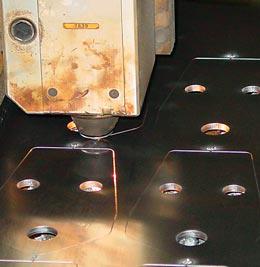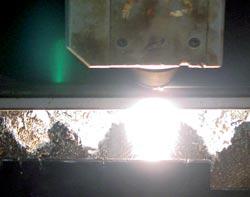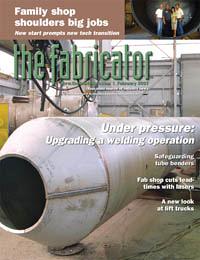- FMA
- The Fabricator
- FABTECH
- Canadian Metalworking
Categories
- Additive Manufacturing
- Aluminum Welding
- Arc Welding
- Assembly and Joining
- Automation and Robotics
- Bending and Forming
- Consumables
- Cutting and Weld Prep
- Electric Vehicles
- En Español
- Finishing
- Hydroforming
- Laser Cutting
- Laser Welding
- Machining
- Manufacturing Software
- Materials Handling
- Metals/Materials
- Oxyfuel Cutting
- Plasma Cutting
- Power Tools
- Punching and Other Holemaking
- Roll Forming
- Safety
- Sawing
- Shearing
- Shop Management
- Testing and Measuring
- Tube and Pipe Fabrication
- Tube and Pipe Production
- Waterjet Cutting
Industry Directory
Webcasts
Podcasts
FAB 40
Advertise
Subscribe
Account Login
Search
Cutting lead-times with lasers
Midwest Precision uses lasers to cut sheet, tube, and now plate
- February 13, 2007
- Article
- Laser Cutting
Midwest Precision (MPI), Tulsa, Okla., has held onto its goal of remaining flexible since opening in 1973. Known as Miller Manufacturing back then, the only equipment in the garage were a drill press and a small hand former.
In the beginning the company focused on military electronics. But then company founder Ron Miller expanded his customer base and turned his small garage operation into a business with 60 employees working three shifts. Miller's son, Brian, now is in charge of MPI's day-to-day operations, while Ron manages the broader functions such as financial and property management.
Today the company performs precision metal fabrication for the aircraft, electronics, military, and general manufacturing industries. Its customers include Nautilus®, Peterbilt, Koch-Glitsch, and Cessna.
Among other processes, MPI specializes in laser cutting, as well as CNC punching of all metals, phenolics, glass, and exotic materials, and lately it has been running hard. So hard that within the last five years, the company has doubled in size with two building expansions, increasing square footage from 40,000 to 85,000.
Cutting Down Chinese Competitors
MPI is in a highly competitive marketplace so it needs to be nimble, flexible, and price-competitive. As a one-stop shop offering both waterjet and laser cutting services, it's known for flexibility and the ability to deliver against tight deadlines. Ten years ago lead-times were between four and six weeks. Now the company must complete jobs within a week's time.
Without equipment that is reliable and quick to set up, it would be impossible for MPI to meet these ever-increasing customer demands. Aside from tighter deadlines, competition is tougher too.
"A lot of our competition is in China, but we're closer to home and a little more nimble as far as getting products to market as fast as possible," said Brian Miller.
The company has five laser cutting machines: four TRUMPF units and one six-axis Mazak unit. The lasers run on first and second shift during the week and on a third shift all weekend. It also has two waterjet machines.
MPI has been using TRUMPF punching machines and flat-sheet laser cutters with automatic beam focus. The laser machines cut both 2-D and 3-D, and they can accommodate tube stock in steel, stainless, and aluminum 12 to 60 in. long, up to 1/4-in. walls, and from 0.25 to 4 in. OD.
In the past the company cut tube exclusively on waterjet cutters. But as customers demanded more precise cutting, the company purchased a 6,000-W TRUMPF TruLaser5040, the first of its kind in the area, and utilized the machine to cut aluminum and stainless plate in addition to tube.
"It cuts thicker plates than we were able to cut before, and it also cuts thinner material faster. We have seen an increase in production of about 30 percent, based on the addition of just one machine.
When MPI purchased its first laser 15 years ago, it was mainly used to cut simple parts. Now the company works with OEMs to fully implement the lasers' capabilities beginning in the conceptual phases of their product's life cycle.
According to the company, not only have the lasers become capable of cutting thicker material as well as smaller holes in that material, costs have decreased with automation and cycle times have improved. Product designers now are more familiar with the processing equipment and design products specifically for laser production, Miller said.
"The diversity of the machines is why I like them so much," said Garland. "The laser cutter does exactly what you tell it to do, when you tell it to. There's not very much that we can't run on TRUMPF machines. You're not boxed into the limitations of the machine."
To address the rising cost of assist gas, laser operators are less liberal with nitrogen and use shop air whenever possible. The company also refurbishes some of its head and nozzle components in-house.
Related Companies
subscribe now

The Fabricator is North America's leading magazine for the metal forming and fabricating industry. The magazine delivers the news, technical articles, and case histories that enable fabricators to do their jobs more efficiently. The Fabricator has served the industry since 1970.
start your free subscription- Stay connected from anywhere

Easily access valuable industry resources now with full access to the digital edition of The Fabricator.

Easily access valuable industry resources now with full access to the digital edition of The Welder.

Easily access valuable industry resources now with full access to the digital edition of The Tube and Pipe Journal.
- Podcasting
- Podcast:
- The Fabricator Podcast
- Published:
- 04/16/2024
- Running Time:
- 63:29
In this episode of The Fabricator Podcast, Caleb Chamberlain, co-founder and CEO of OSH Cut, discusses his company’s...
- Industry Events
16th Annual Safety Conference
- April 30 - May 1, 2024
- Elgin,
Pipe and Tube Conference
- May 21 - 22, 2024
- Omaha, NE
World-Class Roll Forming Workshop
- June 5 - 6, 2024
- Louisville, KY
Advanced Laser Application Workshop
- June 25 - 27, 2024
- Novi, MI


































